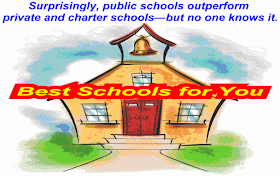The Biggest Public School Problem Might Be the Brand
Surprisingly, public schools outperform private and charter schools—but no one knows it.
Most people believe that charter and private schools are preferable alternatives to traditional public schools. This is evident in the palpable anxiety at school open houses, in overheard conversations at coffee shops, and humorless posts on parent blogs. And it comes across quite clearly in survey data. According to a recent Gallup poll, 78 percent of Americans believe that private schools provide a good or excellent education. Charter schools aren’t far behind, clocking in at 60 percent. And traditional public schools (where the vast majority of K-12 students are educated)? They come in dead last, with only 37 percent of respondents expressing confidence in their merits.
Charter school performance also fails to match public perceptions. As researchindicates, charter school quality varies dramatically, from state to state, and from school to school. And on the whole, charter performance is comparable to that of traditional public schools.
So what accounts for the split between popular perception and actual results?
One factor worth considering is marketing. Gauging school quality from the outside isnotoriously difficult, and it can often take parents years to determine the value of the education their children are receiving. Desperate as they are for information, parents tend to fall back on general brand attributes—turning to crude indicators of quality like the condition of the school’s physical plant or its general reputation, which may have nothing to do with actual effectiveness. Private and charter schools, always vying for clients, are well aware of this. And not surprisingly, they work to shore up their brands by investing in computer labs, creating impressive faculty bio pages, posting cheery banners, and even launching advertising campaigns. For their part, traditional public schools tend not to engage in such practices. After all, they have plenty of clients, and brand status is only loosely tied to actual performance.Public vs Private and Charter Schools: The Biggest Issue Might Be the Brand:

